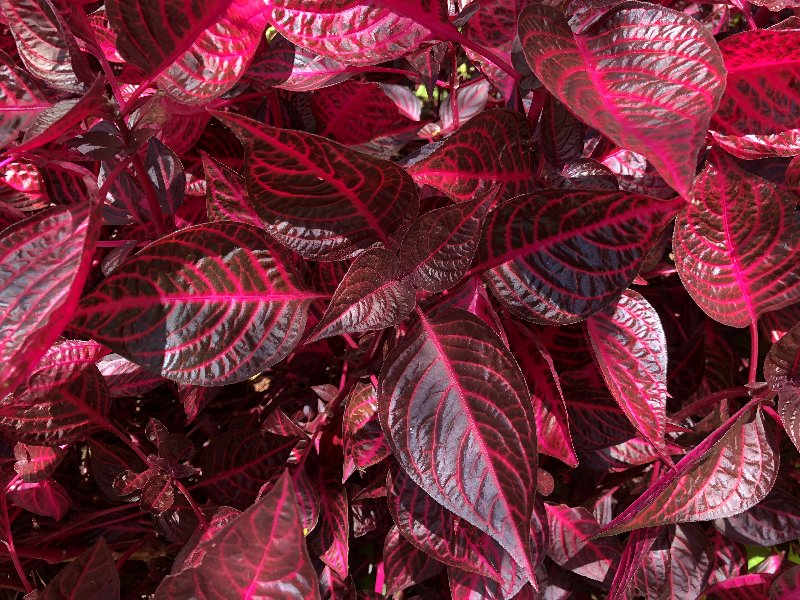
Garden compositions with plants often seek different effects. One may be tonal harmony, where leaves or flowers share a color range. Obviously, green will be the one that blends everything together, in the case of white or bluish blooms, for example, with leaves unifying the color repertoire. Alternatively, one may pursue the opposite effect, where one tone stands out above the rest. This is easily achieved with variegated plants, those with more than one color in their leaves or stems, the result of various causes, such as lack of chlorophyll, which provides whitish or yellowish pigmentation. On these occasions, the variegated plant becomes a focal point where the gaze inevitably rests, captivated by the energetic influence of the lighter colors, among others more intense and loaded.
In a balcony, terrace, or garden, even in a window, one can also opt to change the palette of greens to introduce among them some plants with reddish tones. By doing so, not only will that plant stand out, but it will also make the green ones stand out, making it a wise choice to add these crimson species to compositions.
Introducing Iresine for Vibrant Reds
If one were to mention a plant as an example of these warm tones, it could begin with the iresine (Iresine diffusa f. herbstii), a species that instantly dilates the pupils of those who observe it thanks to the beauty of its strong tones. Its leaves acquire a crimson color, while its veins are lighter, tending towards pink or fuchsia, turning each leaf into a feast for the eyes. Another iresine has light green and cream leaves, which are commonly used in compositions with these plants.
Iresine is perfect for inclusion among other potted plants or even for planting at the foot of taller plants, conveying the powerful vibration of its tones. This South American native does not like cold weather, so it will need protection in winter if the temperature drops below five degrees Celsius. If grown on a terrace with good orientation, not exposed to the coldest winds, it can withstand even lower temperatures. In the warm regions of Spain, it will be happy outside all year round, with very intense lighting. It does not need direct sunlight — which can burn it if too intense in places with less humidity — but if it receives it for a few hours, the iresine will also enjoy it. A perfect exposure for this plant is one where the sun mixes with the shade, under a bush or a tree.
A great idea to showcase this plant in the exteriors of cold regions is to have a pot with iresine as an indoor plant. At the foot of a window, it will bring color, grow healthily, and can be continuously pruned for propagation since it roots extremely easily, both submerged in water and buried in a well-watered substrate. Thus, besides having a highly branched mother plant thanks to continuous trimming, there will be a large number of rooted cuttings that can be inserted into the pots on the terrace where other plants grow or at the foot of garden shrubs.
The reason why this plant enjoys, and makes others enjoy, its red tones is the presence of a reddish pigmentation that masks chlorophyll. This chlorophyll is the green pigment responsible for plants performing photosynthesis, the process by which they extract energy from sunlight.
In iresine, its tonality is produced by a pigment from the anthocyanin group, which provides a reddish, pink, or orangish color to the leaves, flowers, and fruits of many plants, as well as other shades like violet and blue. Anthocyanins are also related to human nutrition since they color fruits like apples, grapes, or strawberries with their purple and reddish hues. For that same reason, it is a pigment that intervenes in the food industry under the name E163, to give color to juices, candies, jams…
The purpose of these pigments is to protect the plant, as they act like melanin in human skin, preventing tissues from burning due to the sun. Thus, anthocyanins serve as a photoprotector, preventing damage that sunlight could cause to tender plant tissues. For this reason, and as a general rule, it could be said that plants with reddish leaves like exposures where they have quite high illumination, even direct sun for many of them. Not all of them will like to have the sun shining on them from dawn to dusk, as is the case with the red-leaved plum or ornamental plum (Prunus cerasifera var. pissardii), a small tree also grown as a shrubby plant that decorates with its deep red leaves the public parks and private gardens of half of Spain.
In a brief list of other plants with reddish hues to cultivate, cultivars of New Zealand flax (Phormium tenax ‘Purpureum’ and others, even in small sizes), coral bells (Heuchera cv.), Japanese maple (Acer palmatum cv.) or even grasses like Japanese blood grass (Imperata cylindrica ‘Red Baron’) could be added. Everyone should search for one of these tones that convinces them the most, to sprout in their own garden and thus delight the eyes with the reds of their leaves.